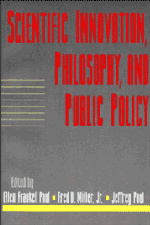Book contents
- Frontmatter
- Contents
- Introduction
- Acknowledgments
- Contributors
- The Human Genome Project: Research Tactics and Economic Strategies
- Choosing Who Will Be Disabled: Genetic Intervention and the Morality of Inclusion
- Germ-Line Genetic Engineering and Moral Diversity: Moral Controversies in a Post-Christian World
- Self-Critical Federal Science? The Ethics Experiment within the U.S. Human Genome Project
- When Politics Drives Science: Lysenko, Gore, and U.S. Biotechnology Policy
- Biotechnology and the Utilitarian Argument for Patents
- Property Rights Theory and the Commons: The Case of Scientific Research
- Property Rights and Technological Innovation
- Medicine, Animal Experimentation, and the Moral Problem of Unfortunate Humans
- A World of Strong Privacy: Promises and Perils of Encryption
- Computer Reliability and Public Policy: Limits of Knowledge of Computer-Based Systems
- Responsibility and Decision Making in the Era of Neural Networks
- Preposterism and Its Consequences
- Index
A World of Strong Privacy: Promises and Perils of Encryption
Published online by Cambridge University Press: 04 August 2010
- Frontmatter
- Contents
- Introduction
- Acknowledgments
- Contributors
- The Human Genome Project: Research Tactics and Economic Strategies
- Choosing Who Will Be Disabled: Genetic Intervention and the Morality of Inclusion
- Germ-Line Genetic Engineering and Moral Diversity: Moral Controversies in a Post-Christian World
- Self-Critical Federal Science? The Ethics Experiment within the U.S. Human Genome Project
- When Politics Drives Science: Lysenko, Gore, and U.S. Biotechnology Policy
- Biotechnology and the Utilitarian Argument for Patents
- Property Rights Theory and the Commons: The Case of Scientific Research
- Property Rights and Technological Innovation
- Medicine, Animal Experimentation, and the Moral Problem of Unfortunate Humans
- A World of Strong Privacy: Promises and Perils of Encryption
- Computer Reliability and Public Policy: Limits of Knowledge of Computer-Based Systems
- Responsibility and Decision Making in the Era of Neural Networks
- Preposterism and Its Consequences
- Index
Summary
A major theme in discussions of the influence of technology on society has been the computer as a threat to privacy. It now appears that the truth is precisely the opposite. Three technologies associated with computers—public-key encryption, networking, and virtual reality—are in the process of giving us a level of privacy never known before. The U.S. government is currently intervening in an attempt, not to protect privacy, but to prevent it.
Section I of this essay is an explanation of the technologies, intended to demonstrate that current developments, if they continue, will produce a world of strong privacy, a world in which large parts of our lives are technologically protected from the observation of others. Section II is a discussion of the likely consequences, attractive and unattractive, of that change. Section III is a brief account of attempts by the U.S. government to prevent or control the rise of strong privacy.
THE TECHNOLOGIES
One way to keep your communications private is to make sure that nobody can intercept them. If you are worried about eavesdroppers, check under the eaves—or hold your confidential conversations in the middle of large open spaces. Send letters only by trusted messengers.
This approach has become more difficult over time, and in some contexts, such as cellular phone calls, very nearly impossible. Broadcast signals can be intercepted. A complicated switching network, such as the phone system, can be tapped.
- Type
- Chapter
- Information
- Scientific Innovation, Philosophy, and Public Policy , pp. 212 - 228Publisher: Cambridge University PressPrint publication year: 1996



